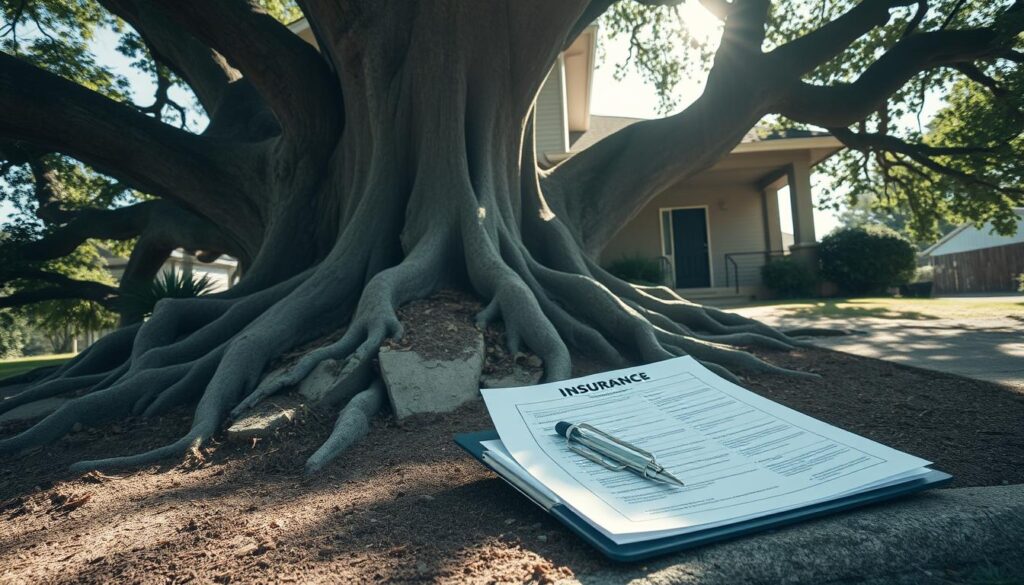Being a homeowner comes with many joys and responsibilities. One of the less pleasant surprises is finding out that tree roots from your yard have damaged your neighbor’s property.
This can be stressful for everyone. You might wonder if your home insurance will help pay for the damage.
It’s important to understand your insurance coverage in such situations. Knowing what is covered and what isn’t can help avoid surprises.
Key Takeaways
- Tree root damage to neighbor’s property can be a complex issue.
- Home insurance may cover some or all of the damage costs.
- Understanding your policy is key to navigating these situations.
- The extent of the damage and policy terms will influence coverage.
- It’s essential to review your policy and consult with your insurer.
Understanding Tree Root Damage and Its Impact
As a homeowner, you might know about the dangers of tree root damage. These roots can harm your property and your neighbors’. It’s key to know the types of damage and their effects to avoid problems.
Common Types of Tree Root Damage
Tree root damage comes in two main types: surface and subsurface.
Surface Root Damage
Surface root damage shows up when roots grow close to the surface. They can crack driveways, sidewalks, and patios. This damage is easy to spot and can be fixed with regular upkeep.
Subsurface Root Damage
Subsurface root damage is harder to see. Roots can sneak into sewer lines, drain pipes, and foundations. This can lead to expensive fixes.
How Tree Roots Can Affect Neighboring Properties
Tree roots don’t care about property lines. They can harm buildings, mess with drainage, and even change soil quality. This affects neighbors too.
| Type of Damage | Description | Potential Impact |
|---|---|---|
| Surface Root Damage | Cracks in driveways, sidewalks, and patios | Aesthetic issues, tripping hazards |
| Subsurface Root Damage | Infiltration of sewer lines, drain pipes, and foundations | Costly repairs, structural damage |
A study found that tree roots cause up to 25% of sewer line problems. This shows why keeping trees in check is so important.
Does Homeowners Insurance Cover Tree Root Damage to Neighbor’s Property?
Many homeowners wonder if their insurance covers damage from tree roots to their neighbor’s property. It’s important to know what your policy covers.
Standard Coverage Policies Explained
Homeowners insurance usually covers sudden damage to neighbors’ properties. But, tree root damage can be tricky. It depends on the situation.
If a tree root suddenly damages a neighbor’s property, it might be covered. But, if the damage happens slowly, it might not be.

Exceptions and Limitations
Even with standard policies, there are exceptions and limits, especially for tree root damage.
Gradual Damage Exclusions
Most policies don’t cover damage that happens slowly. So, if tree roots slowly damage a neighbor’s property, you might not get help with the repairs.
Maintenance-Related Exclusions
Insurance often doesn’t cover damage from not taking care of your trees or property. If the damage is because you didn’t maintain your trees, your insurance might not help your neighbor.
| Coverage Aspect | Description | Typical Coverage |
|---|---|---|
| Sudden Damage | Damage that occurs suddenly and unexpectedly | Generally Covered |
| Gradual Damage | Damage that occurs over a long period | Typically Not Covered |
| Maintenance-Related Damage | Damage resulting from lack of property maintenance | Not Covered |
Liability Coverage for Tree Root Damage
If tree roots from your property damage your neighbor’s, liability coverage might apply. It’s key to understand this part of your homeowners insurance to protect your money.

Liability coverage in your homeowners insurance helps if you’re legally to blame for damage. This includes damage from tree roots.
When You’re Legally Responsible
You could be legally responsible for tree root damage if you didn’t take care of your trees. For example, if you knew your tree was sick and didn’t act, you might be at fault.
- Failure to maintain trees properly
- Ignoring signs of tree disease or decay
- Not taking preventive measures against known risks
Negligence vs. Acts of Nature
Insurance policies split damage into two types: negligence and acts of nature. Negligence means you didn’t act with care. Acts of nature are unexpected events.
For instance, if a healthy tree falls in a storm, it’s usually nature’s fault. But if a rotten tree falls, it’s likely your fault for not removing it.
Key factors to consider:
- The tree’s condition before the damage
- Whether you took steps to prevent damage
- Your policy’s liability coverage details
Does Homeowners Insurance Cover Tree Root Damage to Foundations?
Many homeowners wonder if their insurance covers damage from tree roots to foundations. Tree roots can seriously harm foundations, leading to expensive fixes.

Coverage for Your Own Foundation
Homeowners insurance usually covers damage to your foundation if it’s caused by something covered. But, what’s covered can vary by policy.
- Check your policy: Look over your insurance policy to see what’s included and what’s not.
- Document damage: Keep records of any damage, like photos and repair estimates.
Coverage for Neighbor’s Foundation
Damage from your tree roots to your neighbor’s foundation can be tricky. Liability coverage might apply if you’re found at fault.
- Liability coverage: Know that liability coverage can help if you’re legally to blame.
- Negligence: Find out if negligence was involved, as it can impact insurance coverage.
Talking to your neighbor and possibly your insurance provider is key in these situations.
Tree Root Damage to Sewer Lines and Utilities
Tree roots can damage sewer lines and utilities, leading to expensive repairs and health risks. As a homeowner, it’s important to know the risks and how insurance helps.
Tree roots can get into sewer lines through small cracks or loose joints. This causes blockages or backups. It’s not just frustrating but also dangerous to your health and property.
Is Tree Root Damage Covered by Insurance for Sewer Lines?
Standard homeowners insurance usually doesn’t cover sewer line damage from tree roots. But, some insurance companies offer extra coverage for such damage.
It’s crucial to check your insurance policy to see what’s covered. If you’re not sure, it’s wise to ask your insurance provider for help.
Cross-Property Utility Damage
Tree roots can damage utilities that cross property lines, making things complicated. Figuring out who’s responsible and what insurance covers can be tough.
Talking to your neighbors and insurance providers is important to solve the problem. Knowing what your coverage is and who’s responsible can help reduce the financial and logistical issues.
Filing an Insurance Claim for Tree Root Damage
Filing a claim for tree root damage has several steps. Homeowners need to know these to make the process smoother. Understanding what’s required and how to do it is key.
Documentation Requirements
When you file a claim, having the right documents is crucial. You’ll need proof of the damage and any important records.
Photos and Evidence Collection
Take clear, dated photos of the damage. This visual proof is essential for your claim. Also, keep records of talks with your insurance and any costs related to the damage.
Expert Assessments
At times, you might need an expert to check the damage. They can tell you how bad it is and why. This could mean hiring a professional for a detailed report.
Working with Insurance Adjusters
After you file, an adjuster will contact you. They’ll look into the damage and decide how much your insurance will cover.
It’s important to work well with the adjuster. Give them all the info and documents they ask for. This helps your claim move along faster.
Timeline and Process
The time it takes to process a claim varies. It depends on how complex the case is and how busy the insurance company is. Usually, it takes a few weeks to a few months.
Keeping up with your claim’s status and talking openly with your adjuster helps. It can make things go faster and keep you informed.

Neighbor Disputes Over Tree Root Damage
Dealing with neighbors over tree root damage needs understanding and good communication. When tree roots damage a neighbor’s property, it can lead to arguments. Knowing your duties and how to talk things out is key.
Communication Strategies
Talking things out is the first step in solving neighbor disputes. It’s important to stay calm and listen to your neighbor. Explain the problem, show proof of the damage, and talk about fixing it. Keeping the conversation friendly can help find a solution everyone agrees on.
Mediation Options
If talking doesn’t work, think about mediation. A neutral person can help you and your neighbor find a fair solution. Mediation is less formal and can save money and keep your relationship good.
When Legal Action Becomes Necessary
Sometimes, you might need to go to court. If talking and mediation don’t work, get a lawyer who knows about property disputes. Knowing your rights is important to protect yourself and solve the problem.
Preventing Tree Root Damage to Neighboring Properties
To avoid costly repairs and disputes with your neighbors, it’s key to act early. Keeping your trees healthy and knowing their root systems helps a lot. This way, you can lower the chance of damage to nearby properties.
Regular Tree Maintenance and Inspection
Keeping up with tree maintenance is vital to stop root damage. Check your trees for decay or disease signs. Prune branches to slow down root growth. Also, remove trees that are too close to others or important structures.
Root Barriers and Other Preventive Measures
Putting in root barriers is a smart move to stop tree root damage. These barriers steer roots away from other properties and underground pipes. You can also use physical barriers or plant trees in containers to control root spread.
Choosing the Right Trees for Your Property
When planting new trees, pick ones that won’t damage roots. Some trees grow roots more aggressively than others. Look into the tree’s mature size and root system before planting. Choosing trees with less invasive roots can prevent problems for you and your neighbors.
Legal Considerations and Property Rights
Tree root damage can lead to complex legal issues. As a homeowner, it’s key to understand these laws. This knowledge helps you deal with disputes and damages caused by tree roots.
Tree Ownership Laws
Tree ownership laws differ by place. Usually, the property owner is liable for damage from their tree. Knowing your local laws is crucial for your rights and duties.
Boundary Disputes
Boundary disputes often happen near property lines. Talking clearly with neighbors can avoid these issues. Knowing your legal rights can prevent conflicts.
State-Specific Regulations
States have their own rules for tree care and damage. For example, some laws cover tree roots crossing property lines. Learning about state-specific regulations helps you handle these problems better.
In summary, knowing the legal side of tree root damage protects you. It’s not just about the law. It’s about being a responsible homeowner.
Conclusion: Protecting Your Property and Relationships
As a homeowner, knowing about tree root damage is key. It helps keep your property safe and good relations with neighbors. Understanding your insurance and taking action early can help a lot.
Stopping tree root damage is important to avoid expensive fixes and fights with neighbors. Keeping your trees healthy, checking them often, and using root barriers can help a lot. This way, you can protect your place and your neighbor’s too.
Talking well with your neighbors is also crucial to avoid problems. Knowing the risks and taking steps to fix them helps everyone live better together. This way, you keep your place safe and your neighbors happy.
Being informed and taking action early is the best way to protect your property and keep good relations with neighbors. This balanced approach is key to a peaceful and safe home.
FAQ
Does homeowners insurance cover tree root damage to neighbor’s property?
Homeowners insurance might cover damage to a neighbor’s property from tree roots. But, it depends on your policy’s details. Always check your policy to see what’s included.
Does home insurance cover tree root damage to foundations?
Insurance might help with foundation damage from tree roots. But, it usually depends on the type of damage. Sudden damage might be covered, but gradual damage often isn’t.
Is tree root damage to sewer lines covered by insurance?
Insurance for sewer line damage from tree roots varies. Some policies cover sudden and accidental damage. Others might not. Always check your policy for specifics.
What happens if a neighbor’s tree roots damage my property?
If your neighbor’s tree roots harm your property, you might claim on their insurance. This is if they were careless with their tree. Otherwise, you’ll need to rely on your own insurance.
How do I file an insurance claim for tree root damage?
To file a claim for tree root damage, document the damage well. Take photos and gather evidence. Then, contact your insurance to start the claims process.
Can I prevent tree root damage to neighboring properties?
Yes, you can prevent damage by maintaining your trees regularly. Installing root barriers and choosing the right tree species also helps. These steps can reduce the risk of damage to neighbors’ properties.
Are there any state-specific regulations regarding tree ownership and damage?
Yes, states have laws about tree ownership and damage. Knowing these laws is important. It helps you understand your rights and duties as a property owner.
How can I resolve a dispute with my neighbor over tree root damage?
To solve a dispute with a neighbor, try talking it out first. If that fails, mediation or legal action might be next. Trying to solve it amicably is usually best before going to court.

